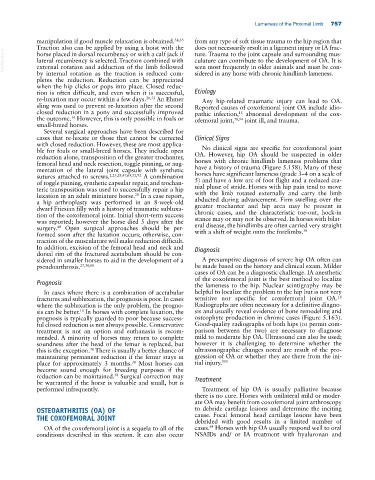Page 791 - Adams and Stashak's Lameness in Horses, 7th Edition
P. 791
Lameness of the Proximal Limb 757
manipulation if good muscle relaxation is obtained. 38,53 from any type of soft tissue trauma to the hip region that
Traction also can be applied by using a hoist with the does not necessarily result in a ligament injury or IA frac-
VetBooks.ir lateral recumbency is selected. Traction combined with culature can contribute to the development of OA. It is
ture. Trauma to the joint capsule and surrounding mus-
horse placed in dorsal recumbency or with a calf jack if
seen most frequently in older animals and must be con-
external rotation and adduction of the limb followed
by internal rotation as the traction is reduced com- sidered in any horse with chronic hindlimb lameness.
pletes the reduction. Reduction can be appreciated
when the hip clicks or pops into place. Closed reduc-
tion is often difficult, and even when it is successful, Etiology
re‐luxation may occur within a few days. 28,53 An Ehmer Any hip‐related traumatic injury can lead to OA.
sling was used to prevent re‐luxation after the second Reported causes of coxofemoral joint OA include idio-
closed reduction in a pony and successfully improved pathic infection, abnormal development of the cox-
15
the outcome. However, this is only possible in foals or ofemoral joint, 78,94 joint ill, and trauma.
16
small‐breed horses.
Several surgical approaches have been described for
cases that re‐luxate or those that cannot be corrected Clinical Signs
with closed reduction. However, these are most applica-
ble for foals or small‐breed horses. They include open No clinical signs are specific for coxofemoral joint
reduction alone, transposition of the greater trochanter, OA. However, hip OA should be suspected in older
femoral head and neck resection, toggle pinning, or aug- horses with chronic hindlimb lameness problems that
mentation of the lateral joint capsule with synthetic have a history of trauma (Figure 5.158). Many of these
sutures attached to screws. 2,23,28,47,69,72,92 A combination horses have significant lameness (grade 3–4 on a scale of
of toggle pinning, synthetic capsular repair, and trochan- 5) and have a low arc of foot flight and a reduced cra-
teric transposition was used to successfully repair a hip nial phase of stride. Horses with hip pain tend to move
luxation in an adult miniature horse. In a case report, with the limb rotated externally and carry the limb
28
a hip arthroplasty was performed in an 8‐week‐old abducted during advancement. Firm swelling over the
dwarf Friesian filly with a history of traumatic subluxa- greater trochanter and hip area may be present in
tion of the coxofemoral joint. Initial short‐term success chronic cases, and the characteristic toe‐out, hock‐in
was reported; however the horse died 5 days after the stance may or may not be observed. In horses with bilat-
surgery. Open surgical approaches should be per- eral disease, the hindlimbs are often carried very straight
40
38
formed soon after the luxation occurs; otherwise, con- with a shift of weight onto the forelimbs.
traction of the musculature will make reduction difficult.
In addition, excision of the femoral head and neck and Diagnosis
dorsal rim of the fractured acetabulum should be con-
sidered in smaller horses to aid in the development of a A presumptive diagnosis of severe hip OA often can
pseudoarthrosis. 27,38,80 be made based on the history and clinical exam. Milder
cases of OA can be a diagnostic challenge. IA anesthetic
of the coxofemoral joint is the best method to localize
Prognosis the lameness to the hip. Nuclear scintigraphy may be
In cases where there is a combination of acetabular helpful to localize the problem to the hip but is not very
18
fractures and subluxation, the prognosis is poor. In cases sensitive nor specific for coxofemoral joint OA.
where the subluxation is the only problem, the progno- Radiographs are often necessary for a definitive diagno-
sis can be better. In horses with complete luxation, the sis and usually reveal evidence of bone remodeling and
10
prognosis is typically guarded to poor because success- osteophyte production in chronic cases (Figure 5.163).
ful closed reduction is not always possible. Conservative Good‐quality radiographs of both hips (to permit com-
treatment is not an option and euthanasia is recom- parison between the two) are necessary to diagnose
mended. A minority of horses may return to complete mild to moderate hip OA. Ultrasound can also be used;
soundness after the head of the femur is replaced, but however it is challenging to determine whether the
this is the exception. There is usually a better chance of ultrasonographic changes noted are result of the pro-
38
maintaining permanent reduction if the femur stays in gression of OA or whether they are there from the ini-
place for approximately 3 months. Most horses can tial injury. 100
38
become sound enough for breeding purposes if the
reduction can be maintained. Surgical correction may
38
be warranted if the horse is valuable and small, but is Treatment
performed infrequently. Treatment of hip OA is usually palliative because
there is no cure. Horses with unilateral mild or moder-
ate OA may benefit from coxofemoral joint arthroscopy
OSTEOARTHRITIS (OA) OF to debride cartilage lesions and determine the inciting
THE COXOFEMORAL JOINT cause. Focal femoral head cartilage lesions have been
debrided with good results in a limited number of
64
OA of the coxofemoral joint is a sequela to all of the cases. Horses with hip OA usually respond well to oral
conditions described in this section. It can also occur NSAIDs and/ or IA treatment with hyaluronan and

